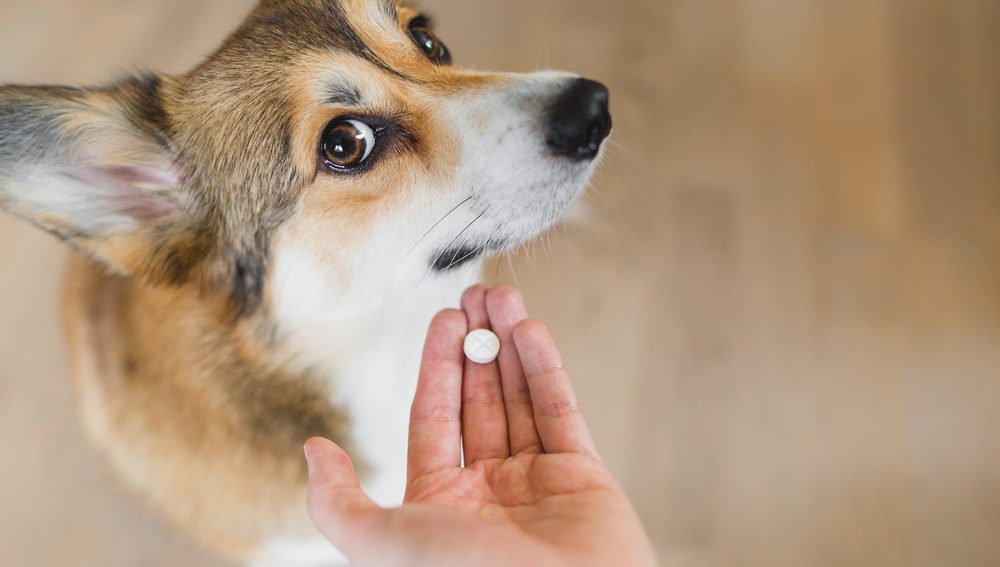
You Need Your Medicine! Advice For Giving Oral Medications To Your Pet
At the conclusion of your pet’s appointment, the veterinary technician reviews your pet’s prescription and hands you the bottle. She asks if you have any questions.
“Well, only one,” you admit, sheepishly. “How am I going to get my dog to take this?”
If you struggle to give oral medication to your pet, you are not alone. So, Harbor Pines Veterinary Center is here to provide some inside knowledge on helping your pet accept—or at least tolerate—pills, tablets, and liquid medication.
Keep calm and prepare to medicate your pet
If you were at the hospital, and a nurse rushed into your room without knocking, dropped her supplies, grabbed your arm, bent it awkwardly, tried to draw blood without taking the cap off, and then spilled the vials, you’d be anxious, right? Does she know what she’s doing?
Our pets may feel the same way. If you are nervous about a process, your pet will know. Plan ahead, have all your supplies ready, and stay calm and neutral. You want your pet to believe what you are doing is no big deal.
Change your pet’s picture
Dogs and cats build strong associations with context, and will inappropriately attach their emotions about an event to a location, person, or object, whether or not they are related. So, let’s start afresh:
- Location — If you previously medicated your pet in the kitchen, try another room.
- Position — Instead of standing, sit down. Leaning over a pet can be threatening. For small pets, put them on a bed or chair that is safe.
- Procedure — Before you begin the medication procedure, reward your pet for simply being with you. That will relax you, too!
- General care — You can use the same location for basic husbandry, such as ear cleaning, teethbrushing, or grooming.
Smells suspicious to your pet
After you have prepared your pet’s medication, wash your hands, because the medication smell can offend cats and dogs. Don’t lose the game before you’ve started, so keep track of what you touch, and wash your hands. Use the following sandwich medicating methods.
Pills and tablets for pets
Like a sandwich, you can surround your pet’s medication experience with so many good things that they do not have time for skepticism. Bookend the medication with high value rewards, using good things, one tiny bad thing, more good things, as the basic pattern.
- The wrap — Use an irresistible treat that can be molded to wrap the pill or tablet, taking care not to use too much, because that will encourage your pet to chew. We suggest:
- Peanut butter, with a little flour added for easier molding
- Cream cheese, also with flour added
- Ready-to-use pill-hiding treats, available in most stores
- Canned food
Do not use any food that has been used previously as the “good thing.” If your pet has dietary restrictions, talk to your veterinarian.
- Placebo — Make about six more identically sized treats, which will be your placebos.
- Sandwich — Feed your pet two to three treats quickly, followed by the medication treat, and then quickly feed two to three more regular treats.
- Final treat — The last treat should always be visible and ready as your pet eats the last part of the sandwich. Now is not the time for savoring.
- The ending — Finish with petting, praise, or toy play.
Liquid medication for pets
Ask your veterinarian for some oral syringes, and follow the same pattern for tablets. Most pets quickly learn to accept syringes if they contain something yummy.
- Dogs — For dogs, let them sample the syringe contents by offering a little from your hand, or letting them lick the end. If your dog is comfortable, place the syringe in their cheek pocket and slowly empty the contents.
- Cats — Do the same for cats, but you will need to gently hold your cat by the head and upper jaw to introduce the syringe. Remember to go slowly.
- Treats — Draw up your pet’s exact dose and mix the medication with some thin yogurt, or a slurry of canned food and water.
- The sandwich — Most pets learn to accept tasty treats from syringes. Once your pet is happily feeding from the treat syringes, feed them from the medication syringe, followed by one or two treat syringes.
Don’t be afraid to ask for help medicating
Unfortunately, some pets have a complex history of fear and anxiety that makes safe medication a risk. If your pet has previously reacted violently to being medicated by vocalizing, struggling, scratching, biting, eliminating, or expressing their anal glands, and you have exhausted your options, please call us at Harbor Pines Veterinary Clinic. We will discuss your pet’s behavior, suggest alternatives, or modify the treatment.
Never discipline your dog or cat for their reaction, because they are responding out of fear and confusion. Punishment may escalate the situation, causing the pet to scratch, lunge, or bite, and is never justified.
Harbor Pines Veterinary Center knows that caring for a sick pet is incredibly stressful. When your pet hurts, you hurt. When we prescribe medication for your pet, we want you to administer the medicine confidently. If you have more questions, or need to schedule an appointment, give us a call.

